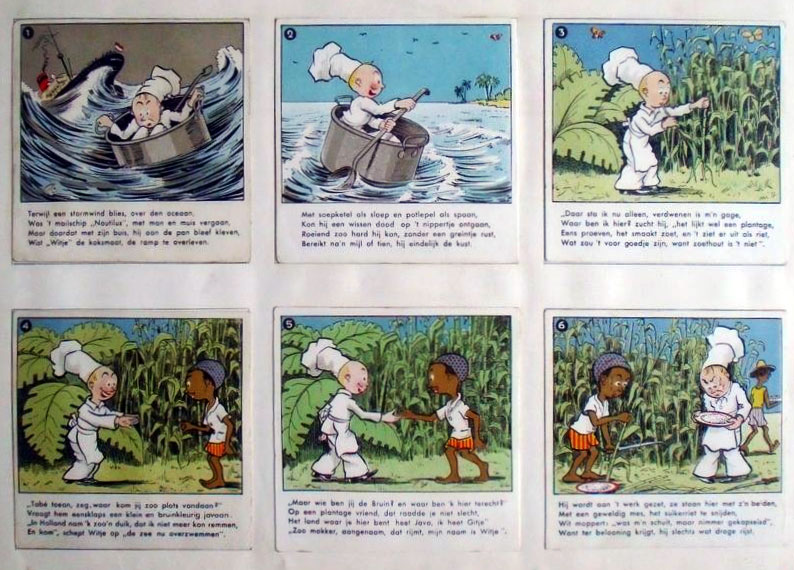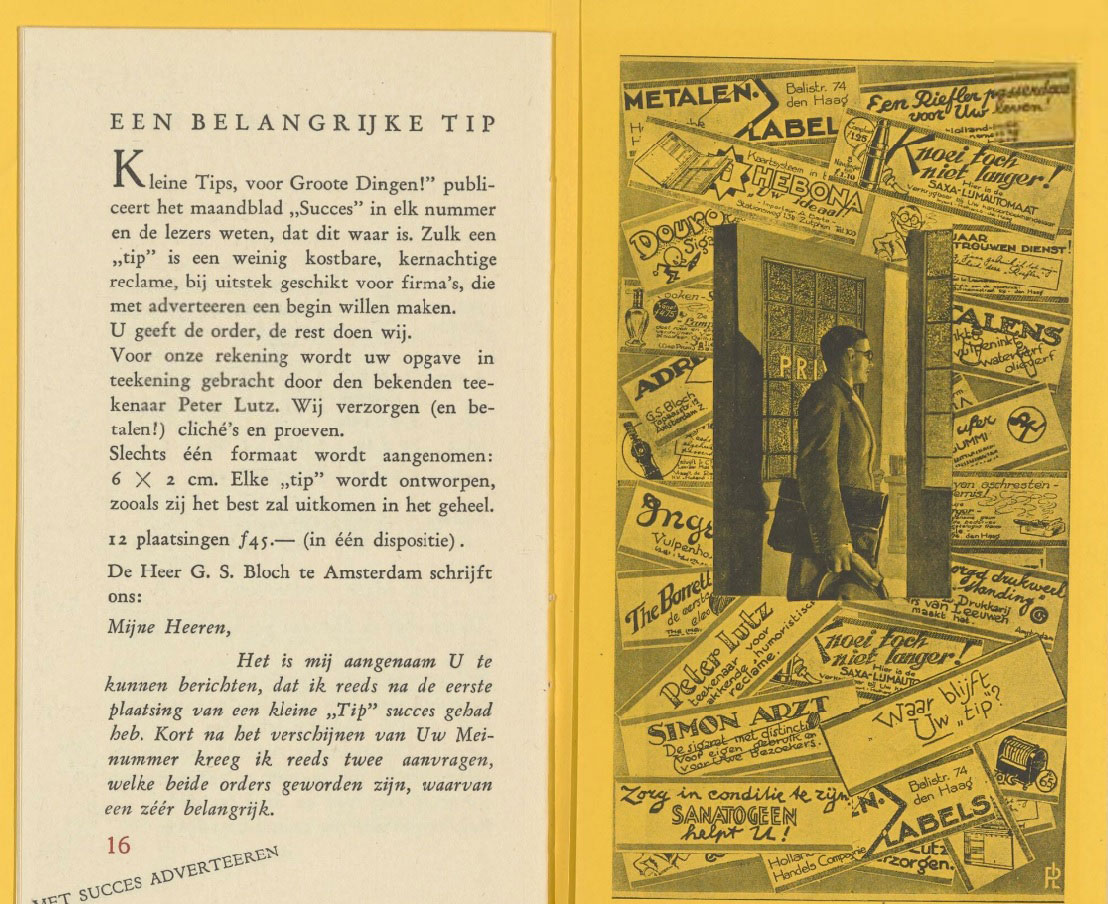'De Lotgevallen van Witje en Gitje' (1932).
Peter Lutz was a Dutch illustrator and comic artist with a long track record in advertising comics. Among his regular clients were the publishers Bosch & Keuning, N.V. Hollandia and De Geïllustreerde Pers, as well as business magazines such as Succes and De Zakenwereld. Among his notable picture stories were 'De Lotgevallen van Witje en Gitje' (1932) for the Dutch Pastry Bakers Association and 'De Neef van Prikkebeen' (1938), starring the son of the Rodolphe Töpffer character Monsieur Cryptogame. In the late 1930s, Lutz also illustrated several promotional strips for Wybert cough lozenges. His 1940s gag comic 'Vader en Keesje', published in the women's magazine Moeder, can be considered as the first known family comic in The Netherlands. Peter Lutz the artist should not be confused with Pieter (Petrus) Lutz the actor (1927-2009).
Early life
Petrus Lutz was born in 1899 in Laren, a town in the Gooi region of the province of North Holland. His father worked as a controller. The youngest in the Lutz family, he received his artistic education at the Quellinus art school for sculptors in Amsterdam. After graduation however, Lutz was first employed by the Dutch Railways. Probably inspired by the success of his illustrator brother Jan Lutz, he later made the switch to freelance illustrator, specializing in commercial art for advertising purposes and magazines. On 24 November 1924, he advertised in the newspaper De Morgen as an artist-for-hire for election posters.
1927 strip for De Zakenwereld, about a man going insane over the constant use of formal writing style in correspondence. In the opening panel he mentions he "doesn't like this style: we don't live in America", indicating that this phenomenon was still unusual in The Netherlands in the late 1920s. This comic is also notable for its use of speech balloons, which was still a rare phenomenon in Dutch comics at the time.
Magazine work
During the 1930s and 1940s, one of Lutz's regular clients was the business monthly Succes and its publishing imprint of the same name in The Hague. For this title, he made illustrations and comic strips about advertising possibilities and commercialism. When in June 1934 the magazine opened new offices, they organized a small exhibition with drawings by their illustrators Peter Lutz and Lou den Hartogh. For the same publisher, Lutz additionally made the current affairs strip 'Filmpje' in the popular science magazine Wereld. Other specialized magazines about commerce of the time with Peter Lutz illustrations were De Middenstandsgids and De Zakenwereld.
In the 1930s, illustrations by Peter Lutz also appeared in the illustrated weekly Astra, the monthly Nova, and in Panorama - Groot Rotterdam, a 1935-1941 regional edition of Panorama magazine. For publisher Bosch & Keuning in Baarn, Peter Lutz made comical drawings about nature-related subjects in the magazine De Libel, as well as the publisher's informational booklets about vegetables and vitamins in the collection Libellen. Throughout the 1940s, Lutz was present in Moeder, a magazine with practical tips for housewives and mothers, published by Zomer & Keuning in Wageningen. For this title, Lutz created what was probably the first family comic in the Netherlands: 'Vader en Keesje', about a clumsy father and his young son. Later in his career, during the 1950s, Peter Lutz was an illustrator for the women's weekly Margriet and its winter annuals.
'Vader en Keesje' (Moeder #3, 1941). The father wonders about his baby son's future and imagines all kinds of professions with a high status, on the basis of the boy's behavior. His dreams are rudely destroyed when a man sees the baby's dirty face and predicts he'll become a chimney sweep.
Books
With his comical drawings, Lutz lightened up books about the animal world, fishing, mopeds and other subjects for publishers like N.V. Hollandia and Kluwer. He additionally illustrated fiction books for Malmberg (Rudi's Avontuur by W. van den Berg, 1928), Bosch & Keuning ('Wonderbare Avonturen van Happerdepap', mid-1930s), W.D. Meinema ('Vervolging en Verraad' by Aart Romijn, 1959) and Hollandia (a translated edition of James Hilton's 'Goodbye, Mr. Chips', 1936). For Van Munster's Handelsonderneming in Zwolle, Peter Lutz created both a picture story and a coloring book about the land of plenty: 'Met de Trein naar Luilekkerland' (1938) and 'Kleurboek in Luilekkerland' (1948).
Commercial comics and picture stories
The most notable part of Peter Lutz's output was done for commercial parties, often for promotional purposes or marketing campaigns. In 1928, he designed the cover illustration of an official publication for the 1928 Olympic Games in Amsterdam, published by department store De Bijenkorf. The 1933 booklet 'Ceta-Bever Gevallen' advertised the bite, varnish and glue of the Ceta Bever factories in Beverwijk. Additionally, Lutz was responsible for several storybooks for children, with collectable pictures to be pasted in the empty spaces. For the Ten Have coffee, tea and tobacco company in Deventer, he illustrated the 1930s booklets 'De Geschiedenis van Langejan en zijn Ezel Caliban' and 'De Verdere Geschiedenis van Langejan en zijn ezel Caliban'. A famous publication was 'De Lotgevallen van Witje en Gitje' (1932), written by Jan Feith and illustrated by Peter Lutz for the Dutch Pastry Bakers Association. The booklet tells the story of a white chef's buddy who ends up stranded on the coast of a distant country, where he comes into contact with a black boy, with whom he has many adventures.
'Avonturen van Prikkebeen Junior' (1938).
Prikkebeen Junior
For the 'Kanarie-boekje' collection of publisher Maandblad Succes, Peter Lutz created the small-format picture story booklet 'Avonturen van Prikkebeen Junior' (1938). In fifty images - one per page - the book told the farcical adventures of Prikkebeen Junior, a clumsy butterfly collector. The story was a reference to 'Histoire de M. Cryptogame' (1830) by the Swiss comics pioneer Rodolphe Töpffer. With a translated narrative written by J.J.A. Goeverneur, that book had become a classic of Dutch children's literature under the title 'Reizen en Avonturen van Mijnheer Prikkebeen' (1858). Lutz's 'Avonturen van Prikkebeen Junior' presented the adventures of Prikkebeen's son, and wasn't the first local variation to the Prikkebeen character. In 1909, Daan Hoeksema drew 'De Neef van Prikkebeen - Reizen en Avonturen', starring Prikkebeen's nephew. In the 1930s, Jac. A. Hazelaar also created a comic featuring Prikkebeen's offspring, 'De Zoon van Prikkebeen'. The Goeverneur adaptation of the original Töppfer story was reworked in the 1940s with new illustrations by Ben Mohr.
Advertising strip for Wybert, as printed in De Prins der Geïllustreerde Bladen on 22 February 1941.
Wybert strips
Between 1938 and 1941, Peter Lutz drew many promotional comic strips for Wybert cough lozenges, printed either horizontally or vertically in magazines and newspapers. In four panels, each strip presented a situation in which someone is bound to catch a cold, only to have this ordeal averted by taking a "Wybertje". German researchers Eckart Sackmann and Siegmund Riedel discovered that the strips were part of an international advertising campaign, with the text captions written by Elly-Heuss-Knapp. In each country, a local illustrator was hired to provide the artwork. While Peter Lutz drew the strips in the Netherlands, the same strips were drawn by other artists in Germany (Emmerich Huber), Switzerland (Hans Schaad), France and Algeria.
Death
Peter Lutz died in Laren in 1973, at the age of 73.
"Tip" of the magazine Succes about the benefits of advertising (1930).








